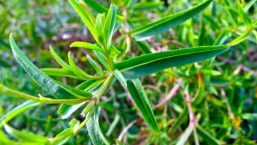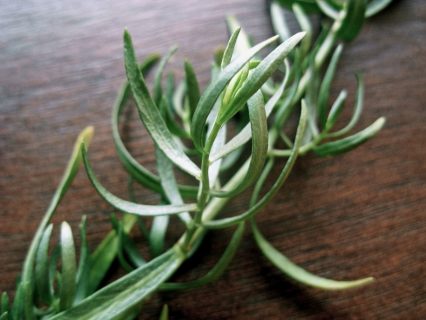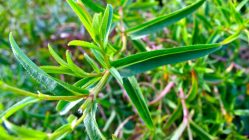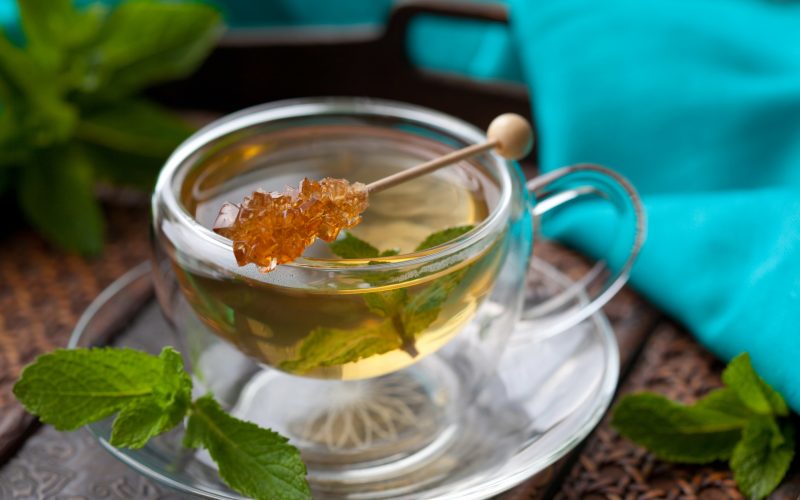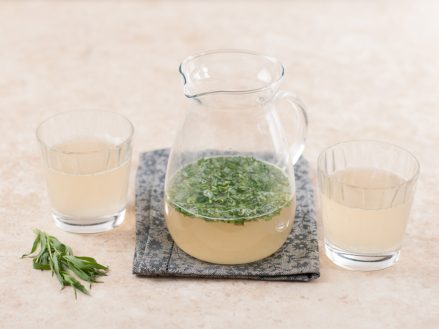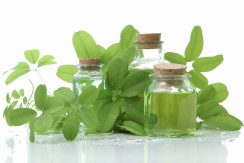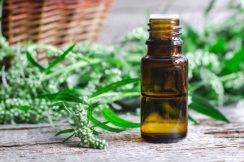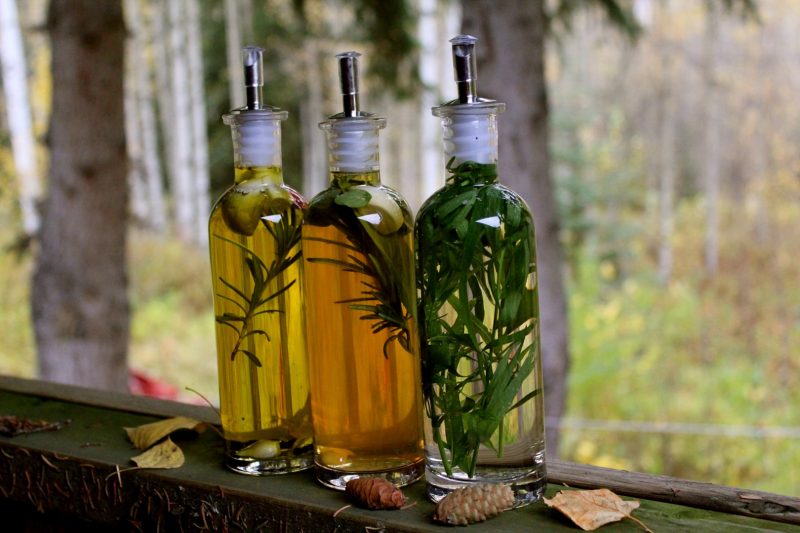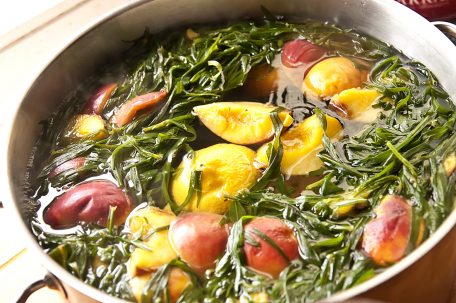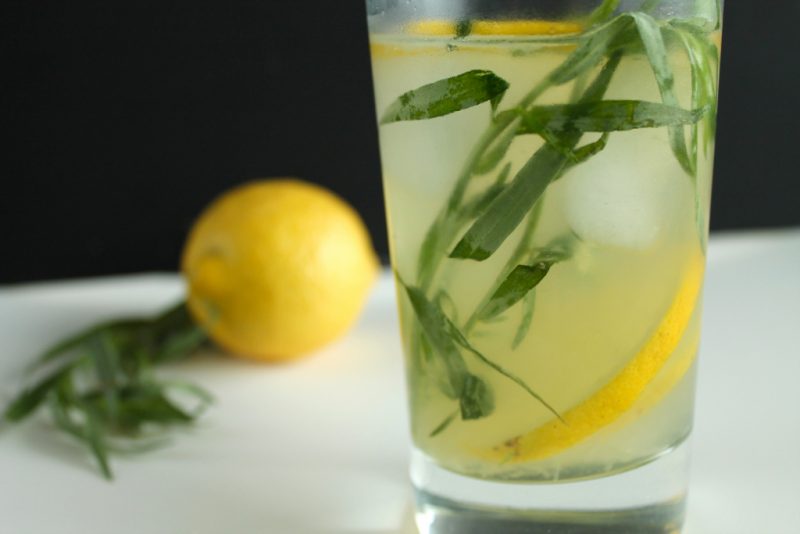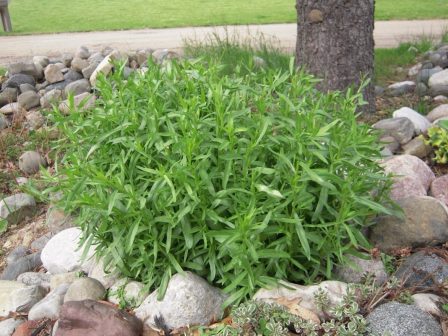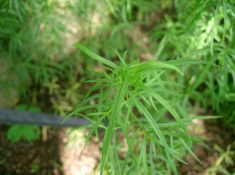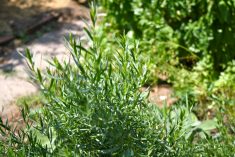Tarragon (other names for tarragon, dragoon-grass) is a perennial herbaceous plant from the genus Wormwood. It is widely used in alternative medicine, cosmetology and cooking over the past centuries.
Material Content:
Tarragon plant: useful and medicinal properties
Despite the fact that tarragon is considered to be grass, its stems in natural conditions can reach 1.5 m in height.
The larger the plant, the more it contains useful components.
The ground is rich in flavonoids. These are substances involved in the cellular metabolism of the human body. They have a pronounced antioxidant property, improve the activity of the cardiovascular system, digestion and brain activity. In some cases, are prescribed for the treatment of diabetes, as they stimulate the production of hormones.
Also, the stems contain a small amount of coumarin, Ocimen and fellandrene. These components have found their application in the perfume industry and medicine. They are used as additives in anticoagulant drugs, i.e., contribute to blood coagulation.
Tarragon leaves are rich in ascorbic acid, carotene, B vitamins, PP, D. Also, the presence of pectins, protein and useful minerals: potassium, iron, selenium, magnesium, phosphorus. Estrogen essential oils contain up to 65% sabinene and up to 10% myrcene, as well as resins and aldehydes. These are aromatic substances that have antimicrobial and disinfecting properties. In high doses, they are found in conifers, so meeting them somewhere else is a great success.
The roots of dragoon herbs are used in traditional and folk medicine due to the presence of alkaloids in them - components that affect the nervous system. When used correctly, they relieve inflammation, reduce the severity of pain, improve sleep, remove fear and anxiety, and fight stress. Some groups of alkaloids stimulate the central nervous system, have an expectorant and wound healing effect, and help in the treatment of alcoholism.
Indications for use
Due to the rich taste and piquant aroma, the plant is added to dietary dishes, instead of salt and spices. But the beneficial properties of tarragon are not limited to this. The content of vitamins and active substances allows you to use it as an auxiliary therapy in the following cases:
- to combat nervous disorders and relieve mental stress;
- improving the functioning of the gastrointestinal tract and increasing appetite;
- reduction of edema;
- increase immunity and resistance to viruses;
- treatment of diseases of the genitourinary system;
- relieving headache and toothache, muscle cramps;
- in men - improve blood circulation in the pelvic organs and increase potency;
- in women - normalization of the menstrual cycle;
- healing of wounds, abrasions, burns;
- for the treatment of vitamin deficiency in children and adults;
- as an antitussive and expectorant in the treatment of diseases of the upper respiratory tract;
- to get rid of intestinal parasites;
- improve blood composition;
- strengthening the walls of blood vessels and capillaries, the work of the heart;
- to normalize hormonal balance;
- as a tonic and tonic for high physical and intellectual stress.
In cooking, tarragon found its application in the form of pickles for preservation, seasoning for cooking meat. Herb is a part of side dishes, salads and soups. In dermatology, the plant is used externally: masks, tonics, decoctions, compresses are prepared from it, and they are also added to lotions and creams.
Harvesting and storage
Tarragon grass is unique in some ways. It can be used in fresh, dried and frozen form, while the content of useful elements remains quite high. The main thing is to follow the rules of procurement and storage.
Harvesting is recommended from July to September, but the best time is mid and late August. Tarragon blooms during this period, so the majority of odorous substances are found in inflorescences.
The cut pieces are knitted into small bundles and dried in a cool dark place. Such grass is stored for no more than 3 years, provided that the container protects the contents from moisture, sunlight and extraneous odors.
Harvesting of roots begins closer to the fall. They dig out only a small part of the roots so that the plant does not die. They are cut into thin circles and dried in the sun. Storage conditions are the same as on the ground parts of the plant. You need to choose a glass or porcelain bowl, with a tight-fitting lid, protect from cold, heat, moisture and the sun.
Some herbalists agree that it is better to make preparations from the tarragon plant in the first two years of its vegetation. It is at this time that the content of active substances is maximum.
As for fresh shoots - they should be in the refrigerator for no more than a week. And in a frozen form, the plant continues to retain its properties for several years. To properly freeze the tarragon, it is enough to rinse it well, dry it with a paper towel, then wrap it with cling film and put it in this form in the freezer.
There is another way. Pour 100-150 ml of dry white wine into a stainless steel pan and evaporate all the alcohol so that about half of the liquid remains. At this time, several bundles of tarragon should be washed, dried and finely chopped. Pour chopped herbs into hot wine and mix. Form portioned balls or briquettes from the resulting mass. Wrap them in film and freeze.
Homemade Tarragon Herb Recipes
On the basis of tarragon, decoctions, infusions, ointments and teas are made.And to enhance the healing properties, the plant is combined with other ingredients.
Teas and decoctions
- Tea for insomnia. In 300 ml of boiling water pour 1 tbsp. l dry tarragon. Cook with the lid closed on low heat for 2-3 minutes. Allow to infuse for half an hour, then strain. Drink 100 ml at bedtime.
- A decoction to strengthen the nervous system and relieve headaches. Pour a spoonful of chopped tarragon into 250 ml of water. Bring to a boil and cook for another 5-6 minutes. Insist for 1-2 hours. In the resulting broth, a handkerchief is moistened and applied to the forehead.
- Infusion for the prevention of appendicitis. Pour a handful of dry tarragon into a glass of boiling water. Insist for 30 minutes, then strain. Drink 15 minutes before meals for 3 days. Important! This is just a preventative measure. With exacerbation of appendicitis - self-medication is contraindicated.
- Vitamin tea. To a glass of boiling water add a pinch of green tea, crushed leaves of tarragon and 2 handfuls of washed pomegranate peel. Insist in a teapot for 20-30 minutes. Dilute with water before use. Add sugar, honey or lemon to taste.
- Infusion for getting rid of rash and itching. Mix the dry ingredients of medicinal herbs in the following proportions: 3 parts of chamomile and burdock root, 2 parts of nettle and motherwort, 1 part of thyme and tarragon. Pour a handful of the mixture with 250 ml of boiling water. Insist for an hour and strain. Take 2-3 times a day until symptoms disappear.
It is also permissible to put a few leaves of fresh or dry tarragon to ordinary tea. But such a drink is undesirable to take regularly, because of the risk of adverse reactions.
Healing ointments
For the treatment of skin diseases: eczema, fungus, allergic dermatitis - use the following ointment. In equal proportions combine celandine, tarragon and the stem of nightshade (popularly called “wolfberry”). Grind to a powder and mix with liquid honey in the ratio of 1 part of dry matter to 3 parts of honey. Apply ointment to problem areas 1 time per day for two weeks. Store the finished mixture in the refrigerator.
You can also prepare a universal cream that copes well with radiculitis pain, cracks and ulcers on the skin, stomatitis. You need to melt 100 g of homemade butter and add 2 tsp. tarragon powder. Simmer for 3 minutes, then transfer to a jar and cool. Store the ointment in the cold, use as needed.
Application in cosmetology
The pulp and juices of tarragon contain a large number of vitamins and minerals, which restore youthfulness and elasticity to the skin, and softness and healthy shine to the hair. In cosmetology, both tarragon essential oil (produced mainly in France and the Middle East) is used, combining it with cream or shampoo, as well as a decoction of fresh or dry shoots.
Tarragon based products have lifting and disinfecting effects. They can be used by owners of any type of skin. Below are some recipes for maintaining female beauty.
- Tonic lotion. A few pinches of chopped tarragon pour a glass of boiling water. Insist for 3-4 hours and strain. Wipe the skin of the face, neck, décolleté and hands 2 times a day.
- Whitening lotion. Mix tarragon and cucumber juice in a 1: 1 ratio and add 5 drops of tarragon essential oil. Wipe the face and neck with the mixture.
- Tightening mask. ¾ cup fill with oatmeal porridge, add 3-4 tbsp. l chopped leaves of dragoon herb and pour boiling water. When the mixture has cooled, add 1 egg white and mix well. Apply the mask to clean skin of the face, neck and décolleté for 20-30 minutes. After use, use a moisturizer.
- Mask "Intensive Nutrition". Connect 2-3 tsp. liquid honey with 1 tbsp. l freshly ground tarragon. Apply to the face, avoiding the area around the eyes and lips for 20-25 minutes. Wash off with warm water.
- Broth for hair. Add 2-3 tbsp per liter of boiling water. l shredded leaves. Cook over low heat for 10-15 minutes. Strain through a sieve and cool.Rinse hair after shampooing. It can be applied 2-3 times a week.
- Mask for strength and hair growth. Mix 2 tbsp. l olive and jojoba oils, then add 4 drops of tarragon essential oil. Heat the mixture in a water bath. Massage to the hair roots. Wrap your head with polyethylene and insulate with a towel. Hold for 30-40 minutes, then rinse with shampoo.
Cooking use
Tarragon is widely used in cooking. The aroma of the plant is not very pronounced, and the taste resembles anise. It is better not to heat the fresh leaves, otherwise the dish will slightly bitter. But dry seasoning can be added at any stage of cooking.
As a spice, the tarragon plant began to be used in France. Later this idea was picked up by other European countries: Germany, Italy. Fresh chopped meat was rubbed there with chopped tarragon leaves so that it would be disinfected and stored longer.
Today, tarragon is added to any vegetable salads. The plant brings a pleasant piquancy and serves as a prevention of vitamin deficiency. Dry spice is put in meat and vegetable broths, jellied meat, cheeses, pastries. Seasoning goes well with chicken and lamb.
In France, tarragon is used to make vinegar, which is used for salting fish, and they also prepare the famous Bearn sauce. Fresh branches are used in the production of alcoholic beverages - vodka, liquor, wine. A soft drink with the flavor of tarragon is common in the CIS countries.
Since the plant contains natural preservatives, it is added to pickles and pickles (cucumbers, tomatoes, mushrooms), when pickling cabbage, soaking apples and watermelon.
Homemade Tarhon lemonade
The drink perfectly quenches thirst in the summer, and is also a good prevention of colds and lack of vitamins. You can drink it in the morning on an empty stomach to improve appetite or in the evening to calm the nerves.
In a glass of boiling water add 2 tbsp. l sugar and 100 g chopped tarragon. Boil for 5 minutes over low heat. Add the juice of half a lemon and leave for an hour. Filter the resulting liquid through a sieve or gauze. Dilute the finished drink with boiled or carbonated water to taste.
Instead of sugar, you can put honey, and replace lemon with lime. The amount of ingredients may also vary depending on personal preference.
Contraindications and possible harm
Despite the many useful qualities, there are cases in which this plant can harm.
- Leaves and essential oil should not be used by pregnant and lactating women. Tarragon increases the activity of the uterus and enhances the action of female hormones, which can cause miscarriage and decreased lactation in the postpartum period.
- It is not recommended to be consumed by young children, because the plant contains poisons and in large quantities causes poisoning. And to calculate a harmless dose for a child is very difficult.
- Use with great caution in cases of kidney disease and gallstones. Due to the stimulation of the work of these organs - sand and stones can come out all at once, which will cause discomfort and pain.
- Tarragon is contraindicated at the time of exacerbation of a stomach ulcer and / or duodenal ulcer, as well as gastritis with high acidity.
- Do not use for individual intolerance and severe allergies to chrysanthemums, marigolds and other similar flowers (tarragon is part of the astro family).
Before using tarragon for medicinal purposes, it is advisable to consult a specialist who will prescribe the appropriate dosage and duration of herbal medicine. And, of course, you can’t eat the plant too often or for too long, since the accumulation of phenols and alkaloids that make up the composition can harm health and provoke the opposite effect. Symptoms of an overdose are convulsions, blurred consciousness, nausea, pallor of the skin.



